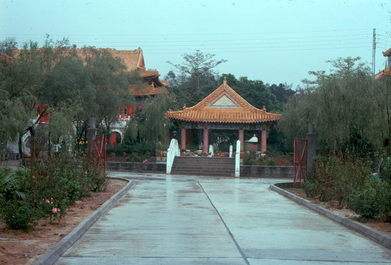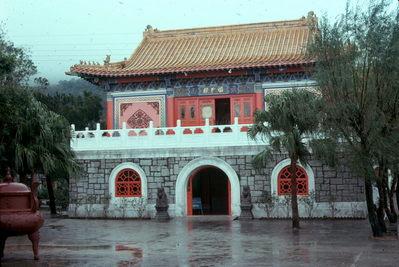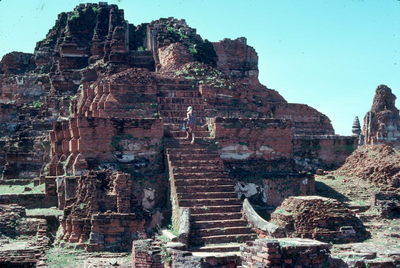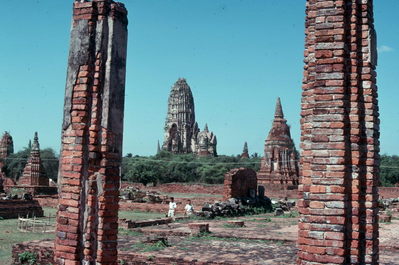 =0=
=0= =0=
=0= =0=
=0= =0=
=0= =0=
=0= =0=
=0= =0=
=0= =0=
=0= =0=
=0= =0=
=0= =0=
=0= =0=
=0=| After visiting the fishing village, we took a van to the other side of the island where there was a Buddhist temple. While waiting for the van I noticed this beautiful view across a lake. If you look closely in this picture you can see that to the right of the lake and just above it there is the trace of the road. That is the road to the temple and there was a little van that took us from the fishing village to the temple. One of the nice things about waiting here was that you could see your bus coming minutes before it actually arrived. |  =0=
=0= |
| This is the gate on approaching the temple just after the little bridge over a stream. The tape talked about a picture of the little bus that took us to the temple, but I couldn't find it. This temple didn't have walls around it like many in Hong Kong did, but it was in a pretty desolate area so they must not have been necessary. Apparently this temple was mostly a vegetarian restaurant that was run by the monks. It seemed to do pretty well allowing them to support these quite nice buildings shown below. They show the main building. The first floor is mostly a restaurant with seating. They also had picnic tables and such for outdoor eating, but the we visited in November and there weren't that many visitors. There was plenty of room for everyone to eat indoors that day which was good as it was cludy and rainy that day (along with a little chilly). On the second floor was the temple proper. |  =0=
=0= |
 =0=
=0= |
 =0=
=0= |
| This is one of the statues of Buddhas upstairs. That concludes the pictures of Hong Kong which was really a city of contrasts. There were many parts which were quite developed and modern and many areas which were still quite traditional. Then we were off to Thailand where we mostly visited Bangkok, the current captial of Thailand. |  =0=
=0= |
| We took a train about an north of Bangkok to Ayuthaya the capital of Thailand from 1350 to 1767. It now had a lot of ruins which we thought were way cool. They mostly dated from around 1200AD when that had been the capital. We hired a guide and pedi-cab which is shown here with Barbara. They were a lot like the older three wheel trucks in Korea with tiny two cycle motors, sounding like the little Honda 90cc motor cycles. They never went very fast, but you never had very far to go and I assume that they get great gas milage. |  =0=
=0= |
| There were lots of ruins, some of them quite large. This is one of the larger ruins with Barbara climbing them. As you can see there were no fences or barriers so you were free to go where you please which impressed us. I also climbed this ruin and then took pictures from the top which are shown below. You can see the outline and form of some of the buildings that were in the area. |  =0=
=0= |
 =0=
=0= |
 =0=
=0= |
 =0=
=0= |
 =0=
=0= |
| The ruins went on for quite a distance as you can see in the pictures above. Later we would visit the current capital grounds which were also quite large and spread out over a large area. The is a picture of one of the common shapes for their monuments which was a sort of corn cob shape though I don't know the proper name for it. |  =0=
=0= |
This page was last updated on October 22, 2005.